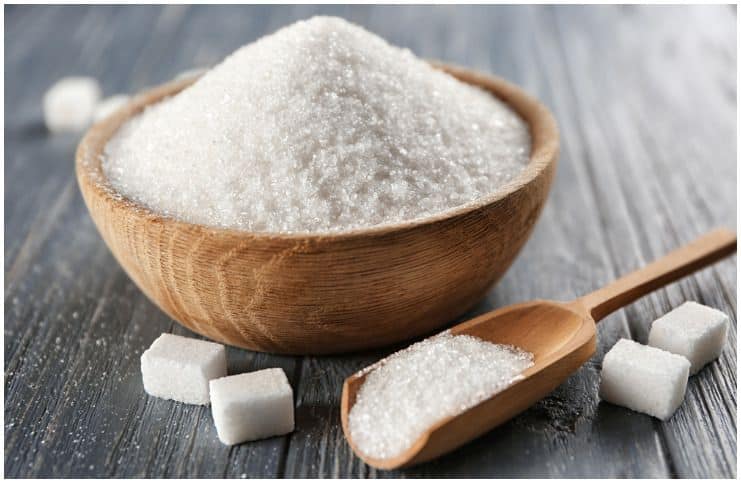Ribose vs Deoxyribose – detailed comparison:
Ribose
It is a pentose monosaccharide with the formula C5H10O5, specifically, it is a simple sugar that has all the hydroxyl groups on the same part in the Fischer projection (a 2-dimensional representation of a 3-dimensional organic molecule by projection).
Its backbone is a chain of 5 carbon atoms – 4 of them carry an OH group, the 5th an oxygen atom that is attached by a double bond.
Unlike glucose, ribose is not directly oxidized to provide energy for cellular metabolism. However, it is incorporated into molecules which are used to transfer energy from place to place within the cells.
It has a melting point of 91° C, a molecular weight of 134.13 g/mol, and like all carbohydrates, it is very soluble in water.
This simple sugar was discovered in 1905 by Phoebus Levene, a Russian-born American chemist and pioneer in the study of nucleic acids.
In 1983, H.G. Zimmer began the first animal research that looked at ribose effects on rats with reduced heart function.
Functions & Uses
D-ribose, together with adenine (a purine base), makes the adenosine molecule of adenosine triphosphate, the main transportation and storage unit of energy. Synthesis of adenosine triphosphate within mitochondria is vital for producing the energy required for normal cellular processes.
READ MORE: Spiritual Meaning Of Appendicitis
Fibromyalgia
This simple sugar is used in medicinal practice to improve exercise performance and increase muscle energy. Sufferers who experience chronic fatigue syndrome and fibromyalgia (a medical condition characterized by a heightened pain response to pressure and chronic widespread pain) who took a supplement of D-ribose improved their conditions substantially.
In addition, it has been used to improve exercise capacity in individuals with McArdle’s disease, a rare, inherited condition that causes severe muscle pain and cramping.
Also, this simple sugar has been used to prevent symptoms like pain, cramping, and stiffness after physical exercise in sufferers with AMP deaminase deficiency (a condition that is presumably inherited as an autosomal recessive trait) or myoadenylate deaminase deficiency (caused by mutations in the AMPD1 gene, that provides instructions for producing an enzyme called AMP deaminase).
Because D-ribose is a simple sugar, some individuals worry it will raise blood sugar (glucose) levels. However, ribose will not increase your blood glucose level. Actually, there is evidence that it can lower blood glucose levels since it is not used by the human body as a typical sugar – meaning that it is not metabolized via glycolysis (the first step in the breakdown of glucose to extract energy for cellular metabolism).
While this simple sugar is a naturally occurring substance throughout the human body, it is not with a significant concentration in any food. It must be supplemented to have a notable effect.
Supplemental D-ribose can be purchased in a dry powder form, and the powder is mixed in a non-carbonated drink. It has a sweet taste. The usual recommended dosage ranges from 5 to 15g a day and not by body mass units.
It is readily metabolized if consumed within half an hour after being mixed in a fluid.
Note – according to a 2012 study that was issued in the ”Open Pain Journal,” D-ribose supplementation led to a 29% improvement in better mental clarity, sleep, and decreased pain, a 37% increase in well-being, and a 60% increase in energy levels.
READ MORE: Spiritual Meaning Of Liver Disease & Liver Cancer
Deoxyribose
Deoxyribose, also referred to as 2-deoxyribose, is an aldopentose with idealized formula H−(C=O)−(CH2)−(CHOH)3−H.
It is derived from ribose by the replacement of the hydroxyl group at the two positions with hydrogen. This leads to the net loss of an oxygen atom.
Similar to ribose, deoxyribose is a chiral molecule, a property of asymmetry. However, this sugar differs from ribose in that its 2′ carbon is bonded to a hydrogen atom instead of to a hydroxyl group.
The deoxyribose in DNA was first identified in the 1920s. Also, it was synthesized in 1935, however, it was not isolated from DNA until 1954.
Functions
It is the 5-carbon sugar molecule that helps form the phosphate backbone of DNA molecules. DNA is a polymer formed of many nucleic acids.
READ MORE: Spiritual Causes And Meaning Of Hemorrhoids
Bottom Line – Ribose vs Deoxyribose
Ribose is an aldopentose, a pentose sugar with an aldehyde functional group in position one. Deoxyribose is a monosaccharide, the building block for more complicated sugars.
Both are pentose sugars, containing 5 carbon atoms, that are numbered 1′ to 5′, the main marks differentiating these positions from the positions of the nitrogenous bases.
Deoxyribose and ribose are the building blocks of the backbone chains in nucleic acids, better known as RNA and DNA.
Deoxyribose is used in DNA or deoxyribose nucleic acid, a helically twisted double-chain polydeoxyribonucleotide macromolecule that constitutes the genetic material of all organisms with the exception of riboviruses (a group of viruses in which the core consists of RNA).
Ribose is used in RNA or ribonucleic acid, a polymeric molecule important in numerous biological roles in decoding, regulation, and coding of genes. Ribonucleic acid also has a vital role in protein synthesis and other cellular functions (Figure 2.1) and is the main product of gene expression.
The presence of ribose instead of deoxyribose is one difference between RNA and DNA.
Moreover, a deoxyribose is different from a ribose due to the fact that it does not contain the alcohol group and is missing one oxygen atom. This makes it possible for the DNA strands to be condensed in the center of the cells.
In conclusion, RNA is a polymer with a ribose and phosphate backbone and 4 different bases: adenine, cytosine, guanine, and uracil, whereas DNA is a long polymer with a deoxyribose and phosphate backbone and four different bases: adenine, cytosine, guanine, and thymine.
READ THIS NEXT: Spiritual Meaning of Neck and Shoulder Pain
References https://www.ncbi.nlm.nih.gov/pubmed/17109576 https://www.sciencedirect.com/science/article/pii/S0011393X02800546 https://www.ncbi.nlm.nih.gov/pubmed/23265876
